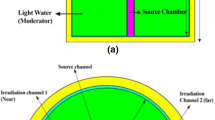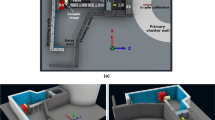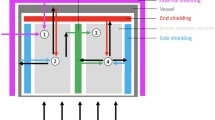Abstract
A moderator of paraffin wax assembly has been demonstrated where its thickness can be optimized to thermalize fast neutrons. The assembly is used for measuring fast neutron flux of a neutron probe at different neutron energies, using BF3 (Φ1″ and 2″) and 3He(Φ0.5″) neutron detectors. The paraffin wax thickness was optimized at 6 cm for the neutron probe which contains an Am–Be neutron source. The experimental data are compared with Monte Carlo simulation results using MCNP5 version 1.4. Neutron flux comparison and neutron activation techniques are used for measuring neutron flux of the neutron probe to validate the optimum paraffin moderator thickness in the assembly. The neutron fluxes are measured at (1.17 ± 0.09) × 105 and (1.19 ± 0.1) × 105 n/s, being in agreement with the simulated values. The moderator assembly can easily be utilized for essential requirements of neutron flux measurements.




Similar content being viewed by others
References
R. Bedogni, C. Domingo, N. Roberts et al., Investigation of the neutron spectrum of americium-beryllium sources by Bonner sphere spectrometry. Nucl. Instrum. Methods Phys. Res. Sect. A 763, 547–552 (2014). doi:10.1016/j.nima.2014.06.040
F.D. Becchetti, M. Febbraro, R. Torres-Isea et al., 252Cf fission-neutron spectrum using a simplified time-of-flight setup: an advanced teaching laboratory experiment. Am. J. Phys. 81, 112–119 (2013). doi:10.1119/1.4769032
S. Croft, K.A.Miller, Group representation of the prompt fission neutron spectrum of 252Cf. Esarda Bull., 112–114 (2011). https://esarda.jrc.ec.europa.eu/images//Bulletin/Files/B_2011_046.pdf
J.W. Marsh, D.J. Thomas, M. Burke, High resolution measurements of neutron energy spectra from Am-Be and Am-B neutron sources. Nucl. Instrum. Methods Phys. Res. Sect. A 366, 340–348 (1995). doi:10.1016/0168-9002(95)00613-3
J.H. Wu, Y.J. Xu, S.L. Liu et al., Energy spectrum measurement and dose rate estimation of natural neutrons in Tibet region. Nucl. Sci. Tech. 26, 060202 (2015). doi:10.13538/j.1001-8042/nst.26.060202
Z.G. Jiang, Y.G. Yuan, H.Y. Wang et al., Development of a spherical tissue equivalent proportional counter for neutron monitoring. Nucl. Sci. Tech. 26, 060403 (2015). doi:10.13538/j.1001-8042/nst.26.060403
B. Wolle, R. BÃtzner, T. Baloui, Special absorber neutron detector moderator assembly: a new detector system for flux measurements of collimated 2.5 MeV neutrons. Rev. Sci. Instrum. 70, 1194–1196 (1999). doi:10.1063/1.1149322
M.A. Rana, Research and applications of nuclear tracks: developments in Pakistan and global comparison. Nat. Sci. (2012). doi:10.4236/ns.2012.431124
G.F. Knoll, Radiation detection and measurement (Wiley, New York, 2000)
M.U. Rajput, N.L. Maidana, V.R. Vanin et al., Measurement of thermal neutron cross section and resonance integral for the 165Ho(n, γ) 166Ho reaction. Radiochim. Acta Int. J. Chem. Asp. Nucl. Sci. Technol. 97, 63–69 (2009). doi:10.1524/ract.2009.1575
M. Akram, A. Iqbal, S.N. Husaini et al., Determination of boron contents in water samples collected from the Neelum valley, Azad Kashmir, Pakistan. Biol. Trace Elem Res. 139, 287–295 (2011). doi:10.1007/s12011-010-8665-6
K. Haygarth, D. Janik, I. Janik et al., Neutron and β/γ radiolysis of water up to supercritical conditions. 1. β/γ yields for H2, H· atom, and hydrated electron. J. Phys. Chem. A 114, 5034 (2010). doi:10.1021/jp101790p
M. Barbagallo, L. Cosentino, V. Forcina et al., Thermal neutron detection using a silicon pad detector and 6LiF removable converters. Rev. Sci. Instrum. 84, 033503 (2013). doi:10.1063/1.4794768
A.A. Naqvi, M.S. Abdelmonem, G. Al-Misned et al., New source-moderator geometry to improve performance of 252 Cf and 241 Am-Be source-based PGNAA setups. Nucl. Instrum. Methods Phys. Res. Sect. A 562, 358–364 (2006). doi:10.1016/j.nima.2006.02.004
S. Ahmad, S.S. Hussain, M. Sadiq et al., Enhanced and reproducible neutron emission from a plasma focus with pre-ionization induced by depleted uranium (U238). Plasma Phys. Control. Fusion 48, 745 (2006). doi:10.1088/0741-3335/48/6/003
V. Ananiev, A. Belyakov, M. Bulavin, et al., The world’s first pelletized cold neutron moderator at a neutron scattering facility. Nucl. Instrum. Methods Phys. Res. Sect. B 320, 70–74. (2014). http://www1.jinr.ru/Preprints/2012/113(P13-2012-113).pdf
S.N. Ahmed, Physics and engineering of radiation detection (Academic Press, New York, 2007)
M. Zakaullah, A. Waheed, S. Ahmad et al., Study of neutron emission in a low-energy plasma focus with Î2-source-assisted breakdown. Plasma Sources Sci. Technol. 12, 443 (2003). doi:10.1088/0963-0252/12/3/320
M. Zakaullah, K. Alamgir, A. Rasool et al., Correlation of plasma electron temperature with neutron emission in a low-energy plasma focus. IEEE Trans. Plasma Sci. 29, 62–68 (2001). doi:10.1109/27.912943
M. Zakaullah, I. Akhtar, A. Waheed et al., Comparative study of ion, X-ray and neutron emission in a low energy plasma focus. Plasma Sources Sci. Technol. 7, 206 (1998). doi:10.1088/0963-0252/7/2/015
C. International, Neutron probe method using a 503DR Hydroprobe, ICT, Editor, International Pty Ltd: Australia
S.N. Goshal, Nuclear Physics (S Chand Publisher, New Delhi, 1994)
M.H. Jasim, N.T. Abdulameer, Neutron capture cross section measurements of paraffin wax. Int. J. Appl. Innov. Eng. Manag. 3, 112–114 (2014). http://ijaiem.org/volume3issue4/IJAIEM-2014-04-20-034.pdf
V.M. Thakur, A. Jain, K. Biju, et al., Studies on optimization of moderator thickness for BF3 detectors used for monitoring of fissile material. Indian J. Pure Appl. Phys. 50, 811–813 (2012). http://nopr.niscair.res.in/handle/123456789/14910
A.A. Naqvi, M.M. Nagadi, M. Maslehuddin et al., Verification of design calculations of a PGNAA setup using nuclear track detectors. Radiat. Meas. 38, 37–41 (2004). doi:10.1016/S1350-4487(03)00252-X
J.K. Zhao, J.L. Robertson, K.W. Herwig et al., Optimizing moderator dimensions for neutron scattering at the spallation neutron source. Rev. Sci. Instrum. 84, 125104 (2013). doi:10.1063/1.4841875
J.F. Ziegler, M.D. Ziegler, J.P. Biersack, SRIM–The stopping and range of ions in matter (2010). Nucl. Instrum. Methods Phys. Res. Sect. B 268, 1818–1823 (2010). doi:10.1016/j.nimb.2010.02.091
R. A. Forster T.N.K.G., MCNP—A General Monte Carlo N-Particle Transport Code, Version 5. 2003
M. Borsaru, P.L. Eisler, Neutron activation analysis (slow neutrons), in United States Patent, 1982
J.R. Parrington, D.K. Harold, L.B. Susan et al., Chart of radionuclides—Knoll Atomic Power Laboratory (Naval Reactors, US Department of Energy, Washington, DC, 1996)
M.B. Chadwick, M. Herman, P. Obložinský et al., ENDF/B-VII. 1 nuclear data for science and technology: cross sections, covariances, fission product yields and decay data. Nucl. Data Sheets 112, 2887–2996 (2011). doi:10.1016/j.nds.2011.11.002
X-5 Monte Carlo Team, MCNP—A General Monte Carlo N-Particle Transport Code, Version 5 (2003)
M. Tohamy, M. Fayez-Hassan, M.M. Abdel-Khalek, et al., A dual-hemisphere (spherical) irradiation facility for Am-Be neutron field optimization (2009). http://www.iaea.org/inis/collection/NCLCollectionStore/Public/42/009/42009903.pdf
Acknowledgements
The authors gratefully acknowledge services provided by Mr. Usman Ali, RPL, CIIT, in the fabrication of mechanical assembly and safe handling of neutron sources.
Author information
Authors and Affiliations
Corresponding author
Rights and permissions
About this article
Cite this article
Waheed, A., Ali, N., Baloch, M.A. et al. Optimization of moderator assembly for neutron flux measurement: experimental and theoretical approaches. NUCL SCI TECH 28, 61 (2017). https://doi.org/10.1007/s41365-017-0213-z
Received:
Revised:
Accepted:
Published:
DOI: https://doi.org/10.1007/s41365-017-0213-z




